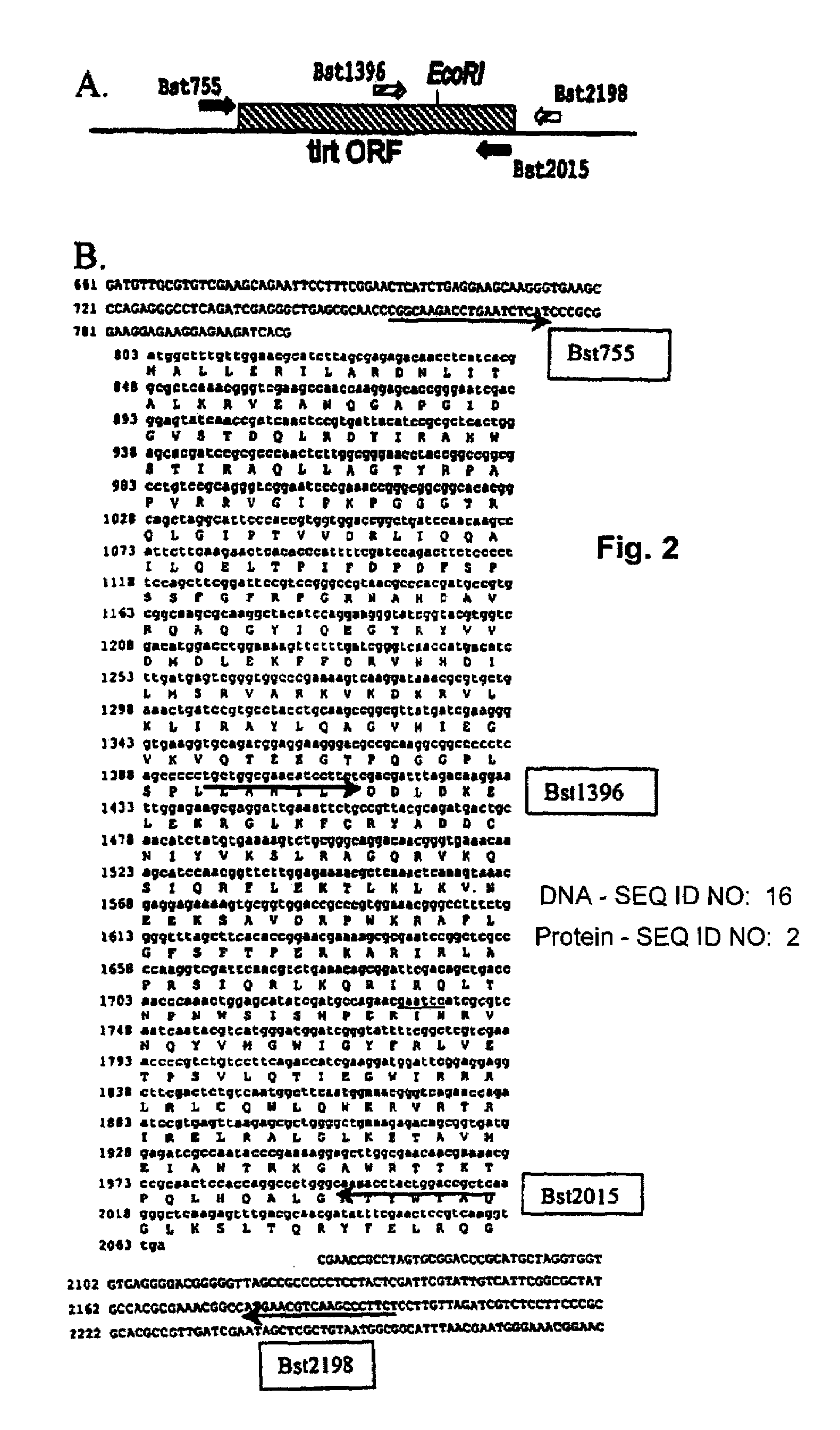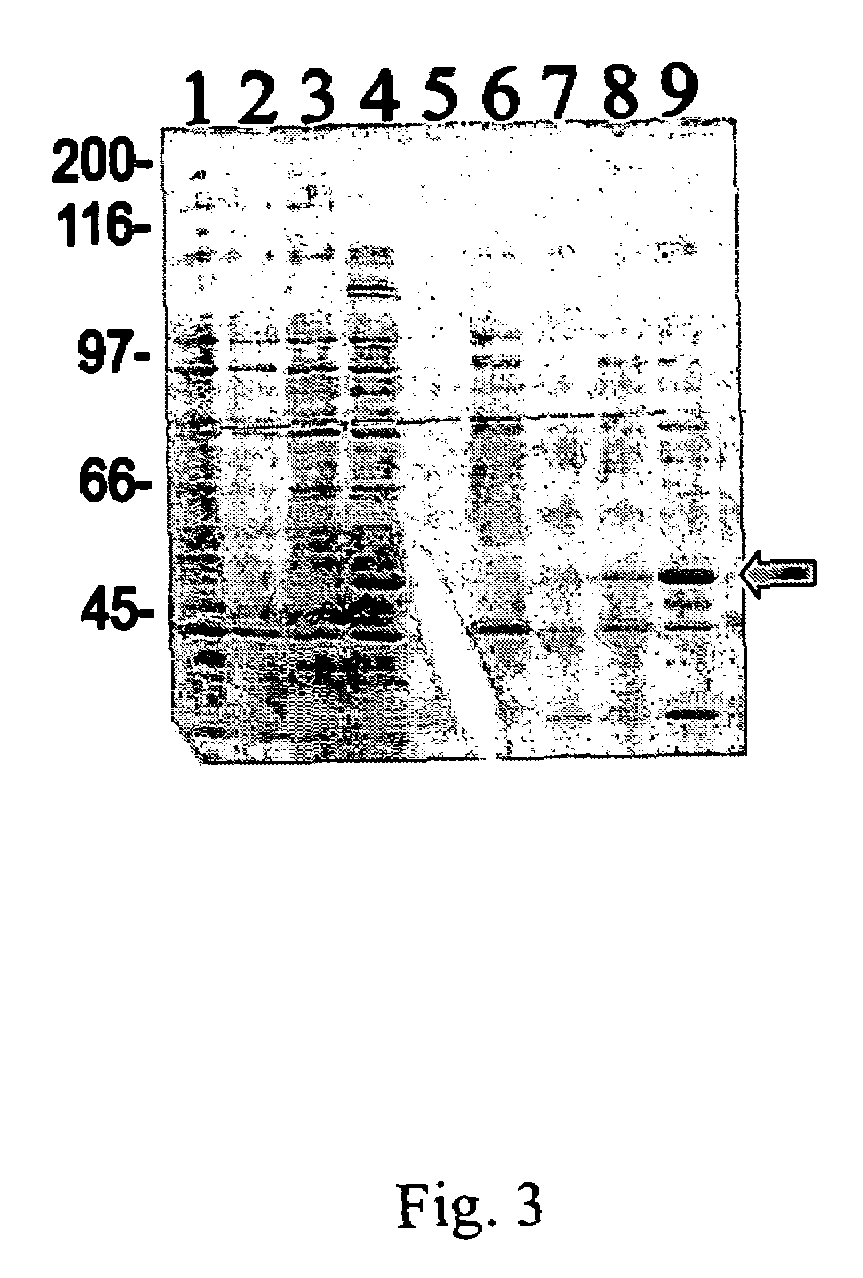RNA-dependent DNA polymerase from Geobacillus stearothermophilus
a dna polymerase and stearothermophilus technology, applied in the field of dna and protein sequences encoding heatstable polymerase enzymes, expression vector constructs, etc., can solve the problems of inhibiting the action of other enzymes, inhibiting the synthesis of primers, and limiting the incorporation of mismatched bases in cdna products, so as to facilitate dna cloning
- Summary
- Abstract
- Description
- Claims
- Application Information
AI Technical Summary
Benefits of technology
Problems solved by technology
Method used
Image
Examples
example 1
Cloning and Expression of the Tirt Gene
[0046]Geobacillus stearothermophilus strain 10 was a kind gift from Dr. Bruce Roe, University of Oklahoma, and was used for cloning the tirt gene. Cultures were grown in trypticase soy agar plates at 55° C. The plasmid pUC18 was used for routine subcloning of DNA fragments. The plasmid pET28a and the E. coli strain BL21(DE3) were from Novagen (Madison, Wis.) and were used for heterologous expression of the Tirt protein in E. coli.
[0047]While multiple sets of oligonucleotide primers were synthesized to amplify the tirt ORF, the inventors found that two pairs of primers could be used to successfully amplifying the tirt gene from the chromosome of G. stearothermophilus. The first primer pair, designated Bst755 and Bst2015 was used to specifically amplify most, but not all, of the tirt ORF via a simple PCR protocol (FIG. 2). A second primer pair designated Bst1396 and Bst2198 was used to amplify a region that includes the last 16 amino acids at th...
example 2
Expression of Tirt Protein
[0050]The plasmid pTirt#16 was used to express the Tirt protein in E. coli by induction of the T-7 promoter system with IPTG. Briefly, protein expression in E. coli was achieved using the T7 RNA polymerase system and the pET28a expression vector (Novagen, Madison, Wis.). Since the upstream primer (SEQ ID NO 4) used to amplify the tirt gene contained an NdeI restriction site, the amplified DNA containing the tirt ORF could be ligated into the NdeI restriction site of the expression vector. This produced an in-frame fusion between the polyhistidine tag element in the pET28a vector and the tirt ORF.
[0051]The Tirt fusion protein was expressed in E. coli strain BL21 lysogenic for μDE3. Briefly, cells of E. coli strain BL21(DE3) transformed with the plasmid pTirt#16 (containing the tirt fusion construct) were induced by addition of IPTG (1 mM). After 3 hours of induction, cells from a 100 ml culture were harvested and resuspended in binding buffer (1×) for nickel...
example 3
Demonstration of Tirt's Reverse Transcriptase Activity
[0054]Column fractions containing the purified Tirt fusion protein were pooled, dialyzed into buffer A (50 mM Tris-pH 7.5, 1 mM EDTA, 1 mM DTT, and 10% glycerol) using a microcon 30 membrane concentrator (Amicon, Beverly, Mass.), and then used to assay for RT activity. A highly sensitive product enhanced reverse transcriptase (PERT) assay was used to detect RT activity. The assay required the reverse transcription of a Brome Mosaic virus (BMV) RNA template to produce a small cDNA that was then further amplified by PCR (FIG. 5). Briefly, the assay was performed by first assembling the PCR amplification reaction mix in the bottom of a 0.2 ml tube containing: MgCl2-free PCR buffer, 1× (Promega, Madison, Wis.), 1 μM each BMV-PCR1 primer (5′-CGTGGTTGACACGCAGACCTCTTAC-3′) [SEQ ID NO: 9] and BMV-PCR2 primer (5′-TCAACACTGTACGGCACCCGCATTC-3′) [SEQ ID NO: 10], 0.8 mM each dNTP, and Taq polymerase (Promega). The RT reaction mix was then ass...
PUM
| Property | Measurement | Unit |
|---|---|---|
| temperatures | aaaaa | aaaaa |
| temperature | aaaaa | aaaaa |
| temperatures | aaaaa | aaaaa |
Abstract
Description
Claims
Application Information
 Login to View More
Login to View More - R&D
- Intellectual Property
- Life Sciences
- Materials
- Tech Scout
- Unparalleled Data Quality
- Higher Quality Content
- 60% Fewer Hallucinations
Browse by: Latest US Patents, China's latest patents, Technical Efficacy Thesaurus, Application Domain, Technology Topic, Popular Technical Reports.
© 2025 PatSnap. All rights reserved.Legal|Privacy policy|Modern Slavery Act Transparency Statement|Sitemap|About US| Contact US: help@patsnap.com



